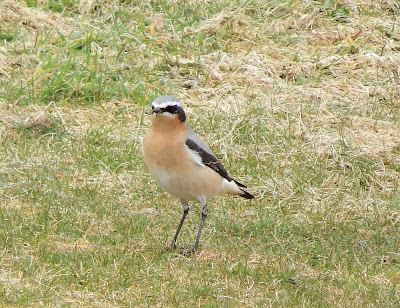Dean reports "Lots of seabird activity as of late with numerous copulating pairs (Razorbill, Guillemot, Fulmar, Kittiwake and Herring Gull) along the west coast. Most of the Shags, Herring Gulls, Lesser Black-backed and Great Black-backed Gulls are now on eggs."
Mallard: A count of 17 birds on 26th – which included 8 ducklings with parents on Rocket Pole Pond.
Water Rail: Single males calling from both Quarters Pond on 26th and from St John’s on 28th.
Golden Plover: One on 25th.
Whimbrel: One calling from below the Terrace on 26th and two feeding on Heather Hill on 28th (see photo).
Kittiwake: 50 birds on territories on 26th including an odd-looking red-legged bird in Jenny's Cove (see photo).
Woodpigeon: Eight on 25th was the highest count of the period, including the long staying tail-less bird that has been hanging around Millcombe – probably the result of a narrow escape from the talons of a Peregrine.
Swift: Three on 26th.
Peregrine: A female was observed numerous times trying to take Fulmars in Jenny’s Cove on 26th.
Goldcrest: One male and one female were caught and ringed in Millcombe on 26th and four birds were seen/heard in Millcombe on 28th.
The past few days have seen some good hirundine passage (finally) including 1,000+ Swallow on the 25th, 600 on 26th, 15 on 27th (a very wet day on the island) and 250+ on 28th. Sand Martins and House Martins have been moving too but in much lower numbers: 25 on 26th and 20 on 28th was the highest count of the period for each species respectively.
Chiffchaff: 32 on 28th, the highest count.
Willow Warbler: 25 on 28th, the highest count.
Blackcap: 30 on 28th, the highest count.
Garden Warbler: The first bird of the year was seen in the Secret Garden on 28th.
Whitethroat: One on 27th.
Grasshopper Warbler: One reeling from the top of Millcombe on 28th was the only record of the period.
Sedge Warbler: Four caught and ringed in Millcombe on 28th.
Spotted Flycatcher: The first birds arrived on 28th (total of three), one of which was caught and ringed in Millcombe (see photo).
Common Redstart: A wonderful adult male was present in Millcombe on 27th and was subsequently caught and ringed on 28th.
White Wagtail: Two birds were recorded in Barton Field on 25th.
Tree Pipit: Two on 26th seen/heard from the Millcombe area.
Greenfinch: A lone female was present in Millcombe during the morning of 28th (see photo).
Bullfinch: At least one female has been recorded in Millcombe every day throughout this period.
Some reasonable passage of both Linnet and Goldfinch throughout the period too, both peaking at on 26th, with 65 and 38 birds, respectively.
During a lull in the wind, Rob Duncan managed to ring 75 birds on 28th, but today, Sun 29th, has brought a chilly north-easterly and Rob reports few migrants around, with a lone Swallow being the only hirundine of the day so far. The most notable sightings have been three Whitethroats, and a Common Sandpiper seen in the Landing Bay by Martyn Roper.
 |
| Aberrant Kittiwake, Jenny's Cove, 26 Apr © Dean Jones |
 |
| Whimbrels, 28 Apr © Dean Jones |
 |
| Female Greenfinch, Millcombe, 28 Apr © Dean Jones |
 |
| Ringed female Linnet, Millcombe, 24 Apr © Dean Jones |
 |
| Spotted Flycatcher, Millcombe, 28 Apr © Dean Jones |














